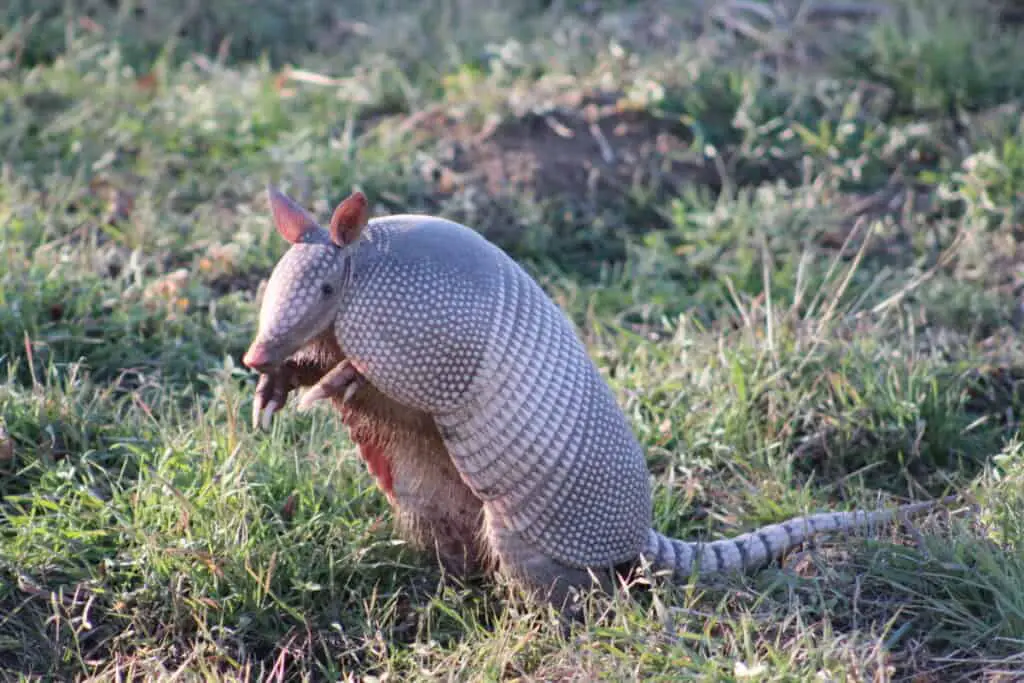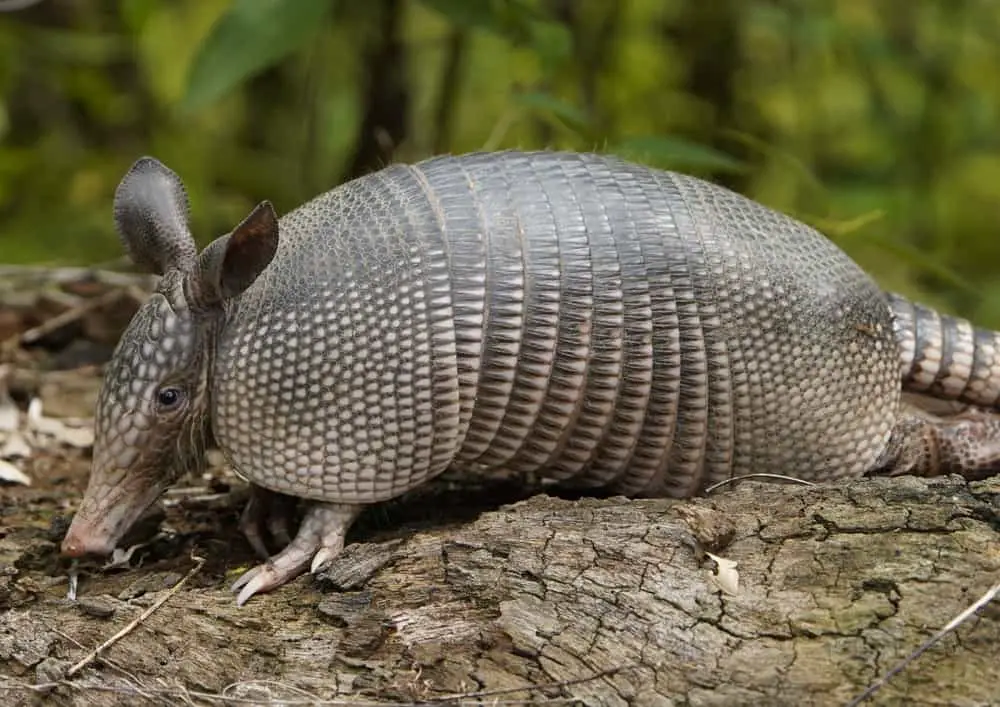The armadillo is a mammal of the family Dasypodidae, characterized by its armor-like shell. It exists in different species and habitats around the world, with most living in Central and South America.
This article will provide an overview of some basic information about armadillos, including their physical characteristics, diet, behavior and potential threats to their existence. Additionally, it will explore how humans interact with these animals and discuss conservation efforts for them.
The structure of an armadillo’s body is composed of overlapping plates that form a protective shell. Its feet are made up of four toes on the forefeet and five on the hind feet, which helps it travel quickly over hard surfaces as well as dig burrows easily.
Armadillos typically have long snouts and small ears; they possess poor vision but sharp senses of hearing and smell which help them detect food and predators from far away distances. They mainly feed on insects such as ants, beetles, grubs and earthworms; however some species also eat fruit or other small mammals like rodents.
Furthermore, they may switch between being solitary or social depending on the season or availability of food sources.

Physical Characteristics
The armadillo is a mammal found primarily in North and South America. It has distinctive physical characteristics, including its hard shell that it uses for protection from predators.
Adaptations of this protective shell include an ability to curl into a ball when threatened, as well as burrowing habits used to escape danger.
Armadillos have an especially thick shell which is made up of ossified bone covered by scutes made of keratin. This provides them with excellent armor against would-be attackers.
Their shells also feature numerous plates that are connected by flexible bands, allowing the animal to move freely while still being protected from harm.
Additionally, their strong claws allow them to dig quickly and efficiently, enabling the animals to hide away in underground tunnels if necessary.
Diet And Feeding Habits
The armadillo is an animal whose diet and feeding habits have been subject to much study. It is a fascinating creature, living its life like clockwork with the same routine day after day.
Its digestive system allows it to make use of almost anything in its environment, from plants to insects and other invertebrates. In order for the armadillo to thrive, certain habitat requirements must be met which include access to food sources as well as sufficient cover for protection from predators.
Armadillos are opportunistic feeders that will exploit whatever resources they can find within their range such as fallen fruits, seeds, grasses, worms and small vertebrates. They may also scavenge on carrion when available. This behavior helps them stay adaptive enough to survive different climates and environmental conditions while still maintaining their dietary needs.
Armadillo’s Natural Foes: Unmasking Their Predators
Behavior And Socialization
Armadillos are small mammals that inhabit a variety of habitats such as grasslands, subtropical and tropical forests. They have distinct burrowing habits which allow them to create deep underground tunnels for shelter and protection from predators. Armadillo behavior is largely nocturnal, meaning they are most active at night when temperatures are cooler and humidity levels are lower.
The socialization of armadillos can vary depending on the species; some species live in large groups while others prefer solitary living.
In general, however, they exhibit several common behaviors:
- Communication: Armadillos communicate through scent marking (urination) or vocalizations like grunts, clicks and purr-like sounds.
- Burrowing: The majority of armadillo species dig their own burrows using their front claws and snout. These burrows provide protection against extreme weather conditions and potential predators.
- Social Interaction: When interacting with other armadillos, individuals may groom each other by licking or sniffing one another’s fur. This helps strengthen bonds between individuals within the group.
Armadillos also show aggression towards members outside of its group or territory, particularly if resources like food or space become limited. To defend themselves from potential threats, armadillos will hiss loudly or puff up their bodies to appear larger than normal. As a last resort they may bite an intruder if provoked enough.
The Sensory World of Aardvarks: How Good Are Their Senses?
Human Interactions
The armadillo has become a symbol of cultural symbolism in many parts of the world. According to a recent study conducted by researchers at Texas A&M University, over 40 different species of armadillo are found throughout South and Central America, making it one of the most diverse mammal families on Earth.
As a result, Armadillos have been kept as pets in various cultures for centuries. In fact, in some countries such as Bolivia and Brazil, owning an armadillo is seen as good luck due to their perceived ability to ward off evil spirits.
| Characteristic | Description |
|---|---|
| Price | Depending on the type and size of the armadillo, prices can range anywhere from $50 – $200 USD per animal. |
| Maintenance | Armadillos require regular feeding and maintenance just like any other pet. Additionally, they need large enclosures that simulate their natural environment which must be cleaned regularly. |
| Behavior | As nocturnal animals, armadillos tend to sleep during the day and come out mostly at night-time when they are more active. They also love digging up holes so owners should consider this when setting up their enclosure or living space. |
| Lifespan | The average lifespan for an armadillo ranges between 8-14 years depending on its diet and living conditions; however some species can live for much longer periods of time if properly cared for. |
From being symbols of cultural significance to becoming popular household pets, the humble armadillo continues to fascinate people around the world with its unique appearance and behavior. With proper care and attention these fascinating creatures can make great companions for life.
Armadillos’ Dietary Secrets Unveiled
Conservation Efforts
The conservation of the armadillo is a crucial matter. The animal’s natural habitat has been largely destroyed due to human development and climate change, which can make it difficult for the species to survive in its native environment.
To address these issues, several measures have been taken:
- Introducing public policies that regulate land-use and reduce deforestation;
- Investing in research programs focused on understanding how changes in climate affect the armadillo’s behavior;
- Developing protected areas where this species can find refuge from human activities.
These efforts are necessary to help preserve one of South America’s most beloved animals so that future generations may enjoy watching them roam their natural habitats.
Unveiling the Sensory Abilities of Armadillos: How Good Are Their Senses?

Potential Threats
The conservation of the armadillo has become increasingly important, due to its threatened status in certain areas. In order to better understand potential threats for this species, it is necessary to review the methods by which they avoid predators and their habitats that are being destroyed.
Armadillos possess several adaptations which enable them to escape from some of their main predators. When feeling a threat nearby, these creatures curl up into an impenetrable ball; not only does this action protect them from attacks but also makes them almost invisible. Additionally, when walking on land or swimming through water, armadillos have evolved the ability to quickly hide in shallow burrows with remarkable speed and agility. Consequently, these strategies lead armadillos to successfully evade predation more often than other similar animals.
However, habitat destruction has become one of the leading contributors to population decline among many wildlife species. This problem tends to be particularly severe in urbanizing regions where natural resources are heavily utilized and developed lands continue to increase at an alarming rate.
As such, these changes can reduce suitable living spaces for the armadillo while simultaneously exposing them to greater risks associated with human activity. Therefore, protective measures must be taken in order preserve their environment if we hope for future generations of armadillos.
Armadillo’s Natural Foes: Unmasking Their Predators
Conclusion
Armadillos are remarkable animals. Their unique physical characteristics, such as their protective outer shells and sharp claws, enable them to survive in a variety of habitats.
They have adapted their diet and feeding habits to suit their environment while they display solitary behavior and socialization when necessary.
While humans may interact with armadillos in different ways, conservation efforts are being made to ensure that these species remain around for generations to come.
Unfortunately, habitat loss due to human activities is one of the leading threats facing this species; over 70% of its original range has been lost since 1900.
It is up to us all to continue protecting our planet’s biodiversity so future generations can appreciate the beauty of wildlife like the armadillo.
